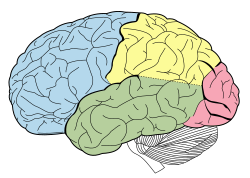Mystical experiences
| Brain lobes | |
|---|---|
|
Lobes of the human brain (temporal lobe is shown in green)
|
|
|
Anatomical terms of neuroanatomy
[]
|
| Insular cortex | |
|---|---|

The insula of the right side, exposed by
removing the opercula. |
|
| Details | |
| Latin | Cortex insularis |
|
Anatomical terms of neuroanatomy
[]
|
|
Scholarly approaches to mysticism include typologies of mysticism, and the explanation of mystical states. Since the 19th century, mystical experience has evolved as a distinctive concept. It is closely related to "mysticism" but lays sole emphasis on the experiential aspect, be it spontaneous or induced by human behavior, whereas mysticism encompasses a broad range of practices aiming at a transformation of the person, not just inducing mystical experiences.
There is a longstanding discussion on the nature of socalled "introvertive mysticism." Perennialists regard this kind of mysticism to be universal. A popular variant of perennialism sees various mystical traditions as pointing to one universal transcendental reality, for which those experiences offer the proof. The perennial position is "largely dismissed by scholars" but "has lost none of its popularity". Instead, a constructionist approach became dominant during the 1970s, which states that mystical experiences are mediated by pre-existing frames of reference, while the attribution approach focuses on the (religious) meaning that is attributed to specific events.
Neurological research reveals which areas in the brain are involved in so-called "mystical experience" both spontaneous and behavioral induced. Especially the brain's temporal lobe seems to have a significant role here.
In mystical and contemplative traditions, mystical experiences are not a goal in themselves, but part of a larger path of self-transformation.
R. C. Zaehner distinguishes three fundamental types of mysticism, namely theistic, monistic and panenhenic ("all-in-one") or natural mysticism. The theistic category includes most forms of Jewish, Christian and Islamic mysticism and occasional Hindu examples such as Ramanuja and the Bhagavad Gita. The monistic type, which according to Zaehner is based upon an experience of the unity of one's soul, includes Buddhism and Hindu schools such as Samhya and Advaita vedanta. Nature mysticism seems to refer to examples that do not fit into one of these two categories.
Zaehner considers theistic mysticism to be superior to the other two categories, because of its appreciation of God, but also because of its strong moral imperative. Zaehner is directly opposing the views of Aldous Huxley. Natural mystical experiences are in Zaehner's view of less value because they do not lead as directly to the virtues of charity and compassion. Zaehner is generally critical of what he sees as narcissistic tendencies in nature mysticism.
...
Wikipedia

